Integrations
What is an Integration?
Integrations allow you to connect PagerTree to other 3rd party tools. Integrations create alerts and assign them to a account user, router or team.
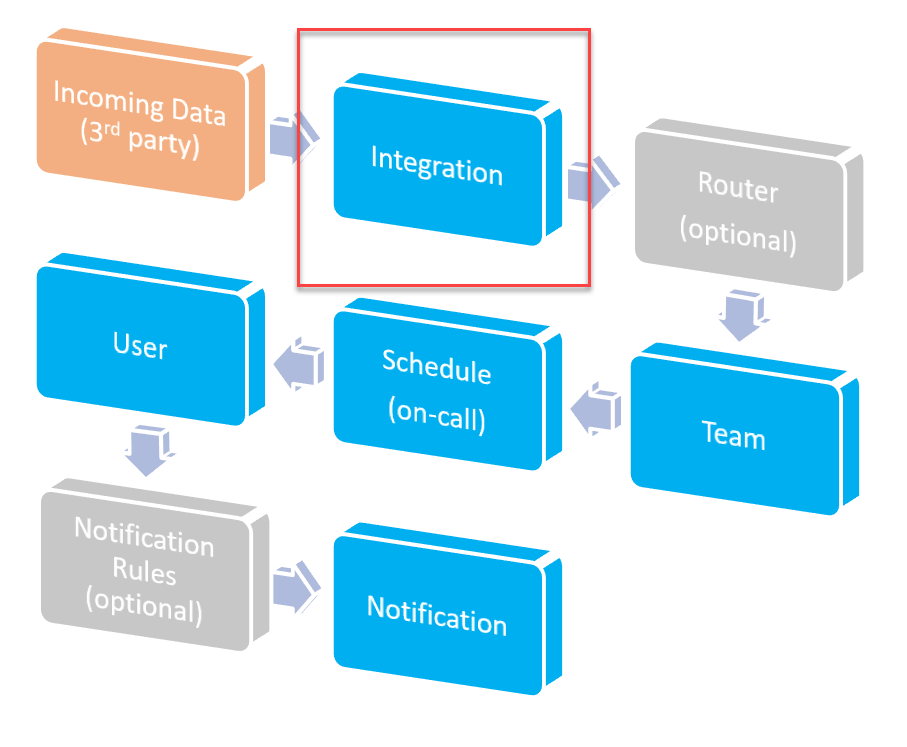
High Level Alert Workflow (Integrations)
For a full list of our supported integrations, please see the integrations page.
Integrations are open sourced and can be found on GitHub.
Integration Options
Every integration type will have different integration options that can be selected. At a minimum the following must be selected:
- Name - A friendly name for your integration.
- Urgency - The urgency of alerts created by the integration.
- Destinations - Where alerts should be sent after they are created by the integration.
For integration specific options, follow the instructions on the new integration form.
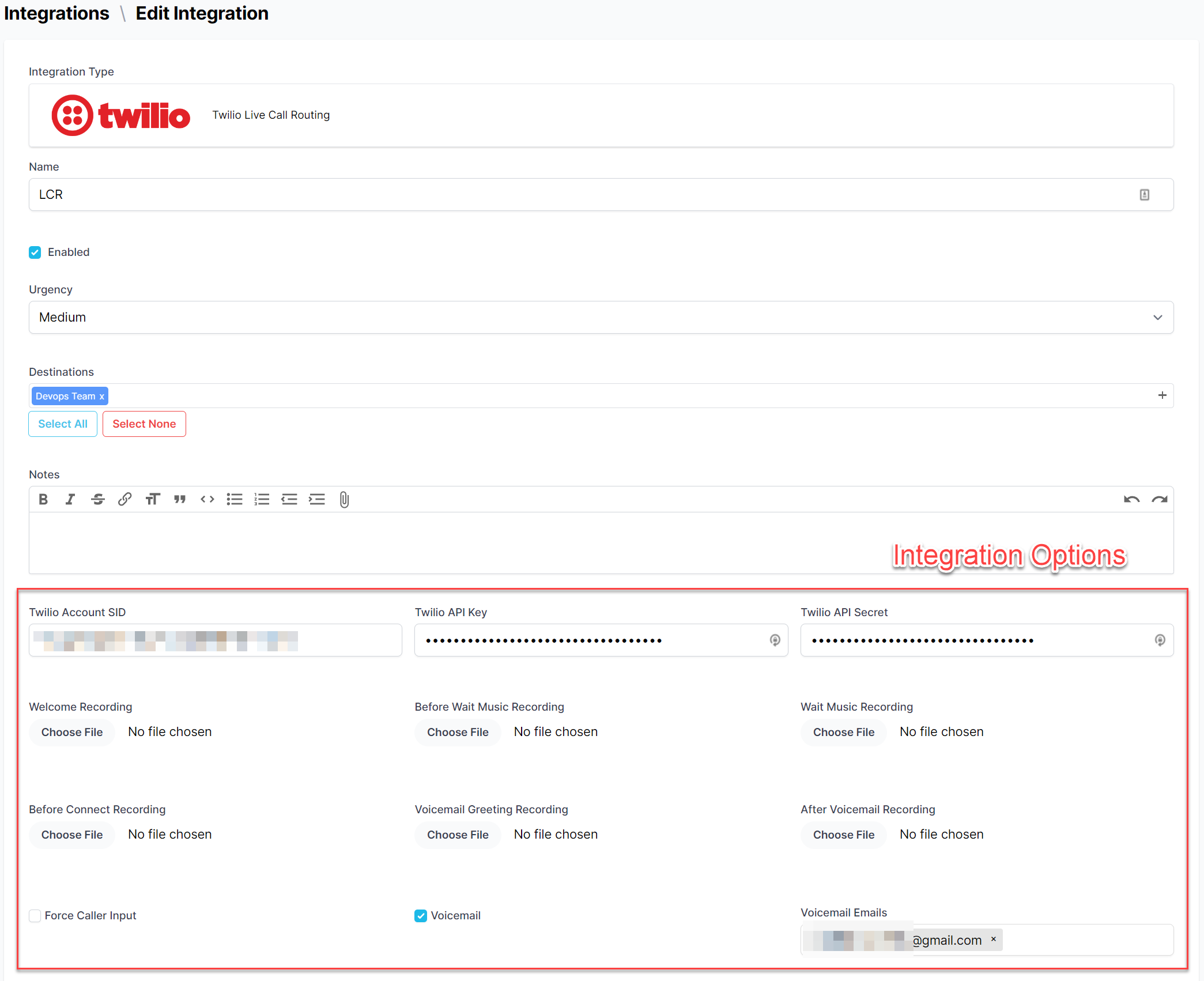
An example of integration options.
Auto Aggregate and Resolve
The auto aggregate and resolve functionality are only available in the Elite pricing plan.
Auto Aggregate
You can configure an integration to aggregate incoming alerts by title to reduce noise. The scope of the aggregation is limited to alerts created by the integration in the queued|open|acknowledged|dropped alert states with an exact match on the title string.
The timeout value is the amount of time PagerTree will look back for alerts with the same title created by the integration and must be between 15 minutes (15m) and 30 days (30d) specified in ms notation.
This feature is useful for integration types like email or webhook, where you want to deduplicate based on the title of an alert instead of the third_party_id (see general alert aggregation below).
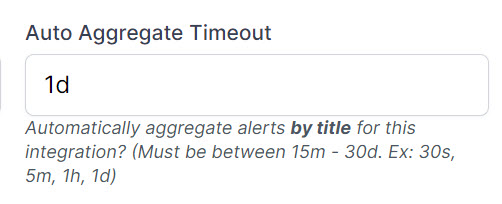
Auto Aggregate by Title Option
Auto Resolve
You can configure integrations to auto-resolve alerts after a period of time. This is useful if your users might not always resolve alerts or if an integration doesn't support resolving an alert natively (ex: email integration).
The timeout value is the amount of time to wait after the alert has been created before auto-resolving the alert. The timeout must be between 15 minutes (15m) and 30 days (30d) specified in ms notation.
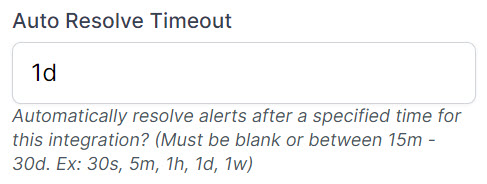
Auto Resolve After Timeout Option
Templates
Each integration supports customizing the alert title and description using handlebars substitution.
- Use the handlebars templating language and any handlebars-helpers to support any logic.
- Use JSON dot notation selection to access deeply nested data (ex:
data.alarm.region). If you are unsure of the data being received by your integration, make sure to check the logs. - The description template supports HTML markup. Use HTML tags to format the description (ex:
<b>,<i>,<br>, etc...).
Handlebars will automatically try to sanitize any HTML or special characters (ex: & < > " ' =) from the input data. Use the triple-stash {{{triple_stash}}} if you want to allow HTML or special tags.
Data
{
integration: {...} // the integration object
data: {
... // what was sent by the integration
// email integration special attributes
to: //the recipients of the email joined by a semi-colon
from: // the sender of the email joined by a semi-colon
subject: // the email subject
message: // the sanitized body of the e-mail
}
}
Email Example

You can use handlebars markup to modify the alert title and description by using the integration title and description templates.
Webhook Example #1 - Referencing JSON body payload
The following example shows how to use the JSON body of the HTTP payload.
{
"event_type": "create",
"Id": "example-id-123",
"Title": "Example Incident Title",
"Description": "Example Incident Description",
"extra": "I want to use this data"
}
-fa27ddca1bc15526203235bcb1f68089.png)
The above would render: "Custom Data - I want to use this data"
Common Mistake: Make sure to use data.<json_body_key>. Do not use data.params.<key> or params.<key>.
Webhook Example #2 - Referencing an integration log
The following example shows how to use integration templates while referencing an integration source log.
{
"url": "https://api.pagertree.com/integration/int_xxxx",
"method": "POST",
"headers": {
"HTTP_VERSION": "HTTP/1.1",
"HTTP_CF_RAY": "abc123-LHR",
...
},
"params": {
"device": "ABC-DEF-GHIJ-01",
"sensorid": "1234",
"sensor": "Free Disk Space (Multi Drive) (WMI Free Disk Space (Multi Disk))",
"status": "Down (previous: Up)",
"pagertree_integration_id": "int_xxxx"
},
"body": "device=...",
"remote_ip": "0.0.0.0"
}
The above would render: "Sensor 1234 is DOWN!"
Common Mistake: Make sure to use data.<json_body_key>. Do not use data.params.<key> or params.<key>.
Troubleshooting Integrations
Integration Logs
- See the logs section on the integration page to see what PagerTree has received from your 3rd party tool.
- Click any log to see more details of what was received.
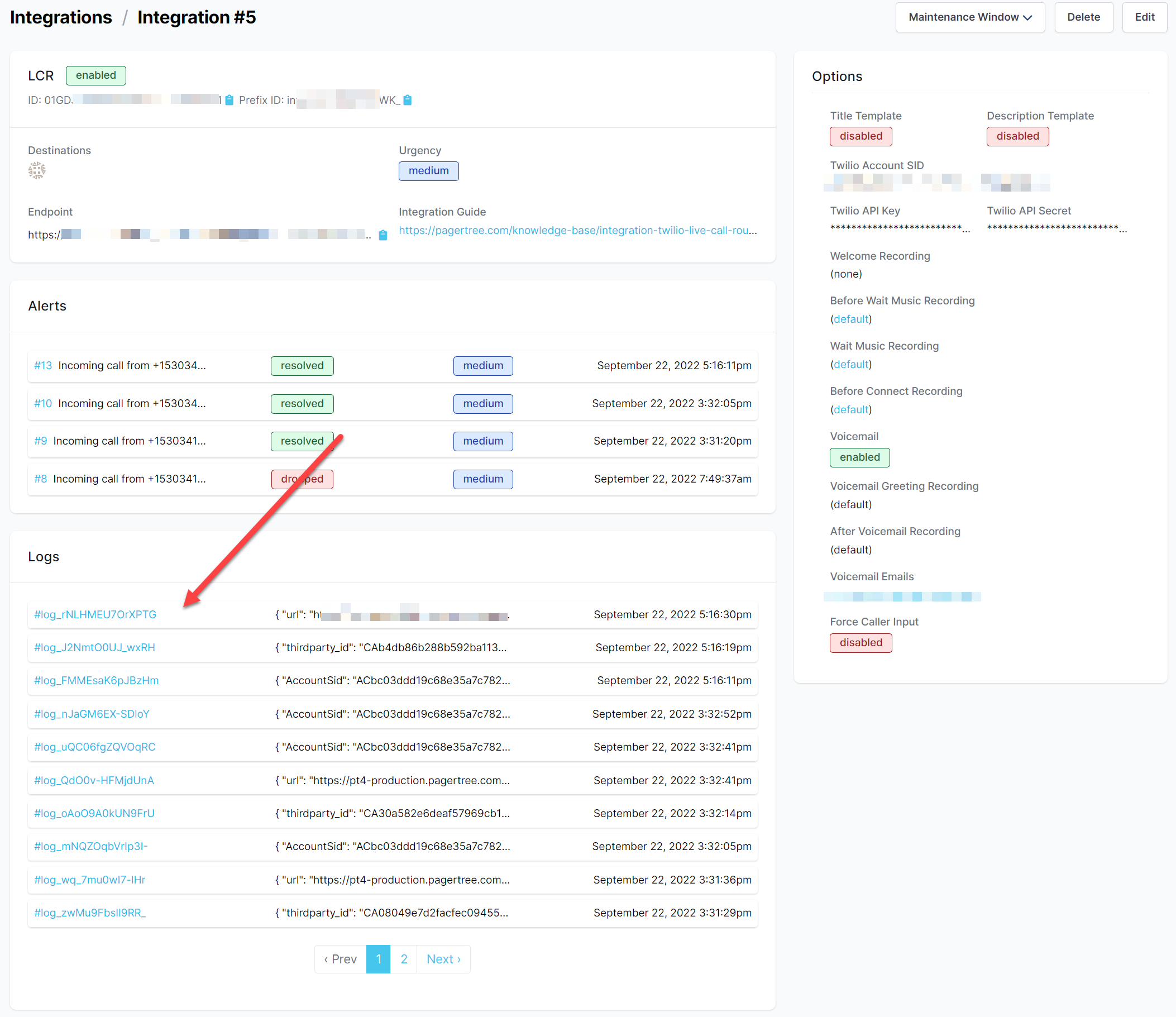
Integration Logs
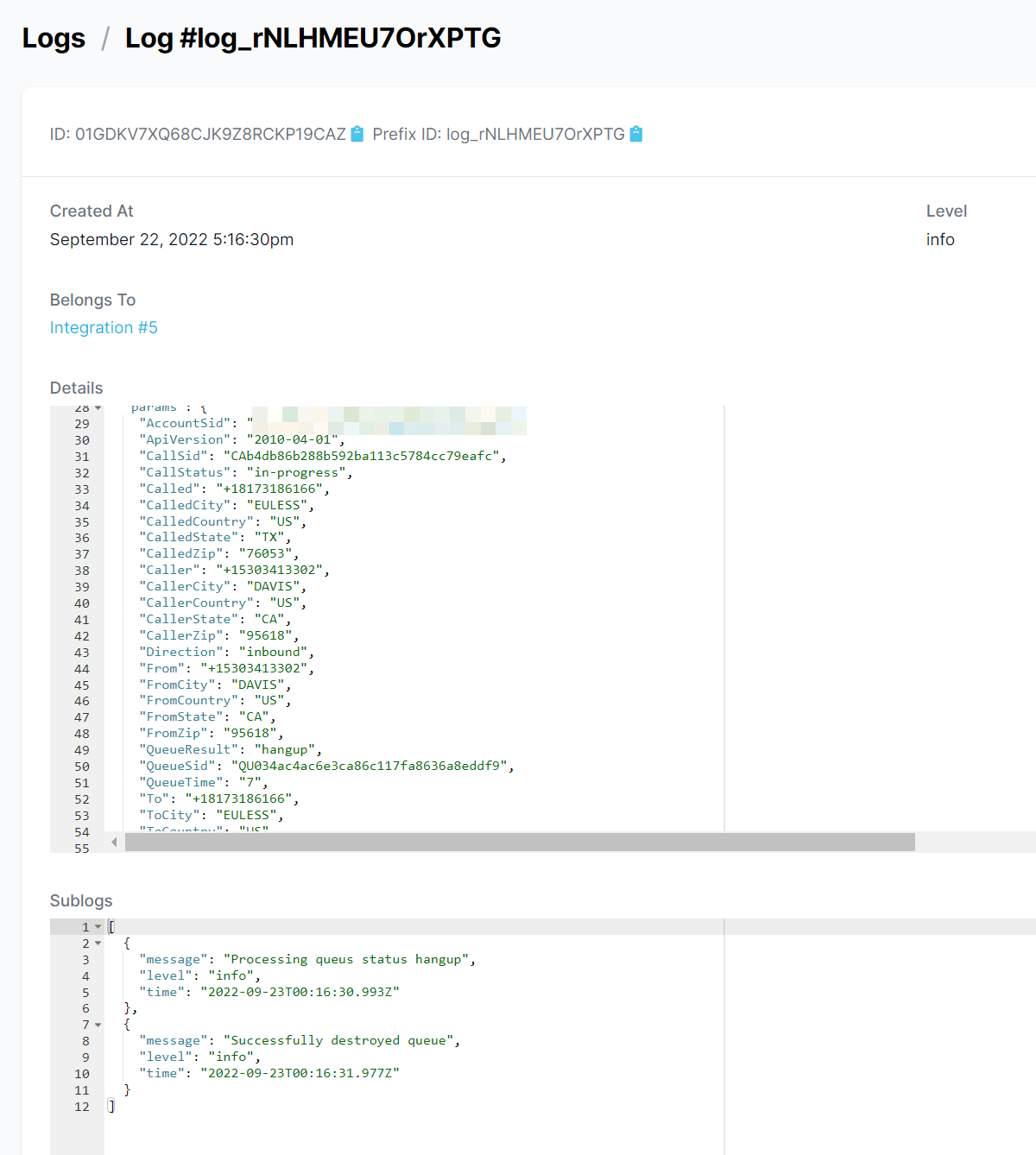
A single integration log.
If you don't see any logs, check your 3rd Party Configuration. A couple of common issues:
- The endpoint url was not correctly copy & pasted.
- The 3rd party tool does not have access to the internet.
- Internal firewall is blocking traffic.
If the logs aren't showing up, it's because PagerTree never received requests from your tool. If you do see logs, but it is still not behaving as expected, please check the source.
Check the Source
Check the source code for your specific integration to see why it might not be working the way you expect.
Integration adapters can be found in this folder. Specifically you should check the adapter_action function. It's normally close to the top of the file and looks like this:
def adapter_action
if _is_create?
:create
elsif _is_resolve?
:resolve
else
:other
end
end
def _is_create?
_state == "triggered"
end
def _is_resolve?
_state == "resolved"
end
def _state
adapter_incoming_request_params.dig("state")
end
Alert Aggregation
To reduce noise PagerTree will try to aggregate incoming alerts by thirdparty_id. The thirdparty_id will differ for each integration, see the source code for your integration to see what the thirdparty_id consists of.
When a "create" request comes in from a 3rd party system, PagerTree check's to see if there is another alert (from the same integration) with the same thirdparty_id in the (queued|open|acknowledged|dropped) state. If there is, PagerTree will increment the dedup count on the existing alert. Else, PagerTree will proceed to create the new alert.
Below is pseudo code showing how PagerTree tries to aggregate the alerts.
alert = integration.alerts
.order(created_at: :desc)
.find_by(thirdparty_id: thirdparty_id)
case action
when :create
if alert && (alert.status_queued? ||
alert.status_open? ||
alert.status_acknowledged? ||
alert.status_dropped?)
# alert already exists, increment dedup count
alert.dedup_count += 1
else
# create a new alert
alert = Alert.new
end
end
# ...
end
Most integrations should handle unique ids for you, but if your integration requires you (ex: webhook integration) or your system (ex: Datadog) to manage the thirdparty_ids. Make sure the following are true:
- The 3rd party system is sending the "resolved" message to PagerTree. This will auto "resolve" the alert in PagerTree.
- Make sure your team is marking the alert as "resolved" in PagerTree. This will allow the system to create a new alert with the same ID.
Alert Aggregation Example #1 (Simple)
This example shows how a properly working integration would send information. Sequentially opening and resolving alerts.
- Integration I1 sends "create" request with thirdparty_id 123.
- Alert A1 is created.
- Integration I1 sends "resolve" request with thirdparty_id 123.
- Alert A1 is resolved.
- Integration I1 sends "create" request with thirdparty_id 123.
- A new alert (Alert A2) is created.
Alert Aggregation Example #2 (Dedup)
This example shows how a noisy integration might send information. Duplicating create events.
- Integration I1 sends "create" request with thirdparty_id 123.
- Alert A1 is created.
- Integration I1 sends "create" request with thirdparty_id 123.
- Existing alert (Alert A1) is found. The existing alert's dedup count is incremented.
- Integration I1 sends "resolve" request with thirdparty_id 123.
- Alert A1 is resolved.
- Integration I1 sends "create" request with thirdparty_id 123.
- A new alert (Alert A2) is created.
Alert Aggregation Example #3 (Multiple Integrations)
This example shows how integrations thirdparty_id namespace is unique.
- Integration I1 sends "create" request with thirdparty_id 123.
- Alert A1 is created.
- Integration I2 sends "create" request with thirdparty_id 123.
- Alert A2 is created.
- Integration I1 sends "resolve" request with thirdparty_id 123.
- Alert A1 is resolved.
- Integration I2 continuously sends "create" requests with thirdparty_id 123.
- Alert A2 dedup count is incremented until it is resolved by "Integration I2" or manually by a User.
Alert Aggregation Example #4 (User Intervention)
This example shows how a user can mark the alert as resolved to reset the deduplication flow.
- Integration I1 sends "create" request with thirdparty_id 123.
- Alert A1 is created.
- User acknowledges Alert A1.
- Integration I1 sends "create" request with thirdparty_id 123.
- Existing Alert A1 is found. The existing alert's dedup count is incremented.
- User manually resolves the alert.
- Alert A1 is resolved.
- Integration I1 sends "create" request with thirdparty_id 123.
- A new alert (Alert A2) is created...